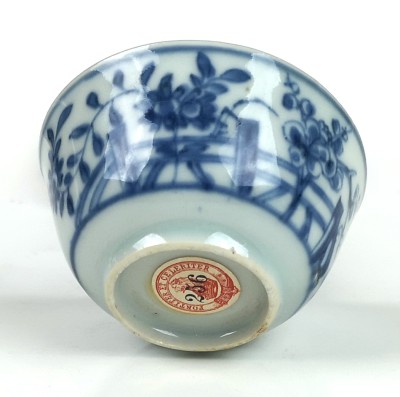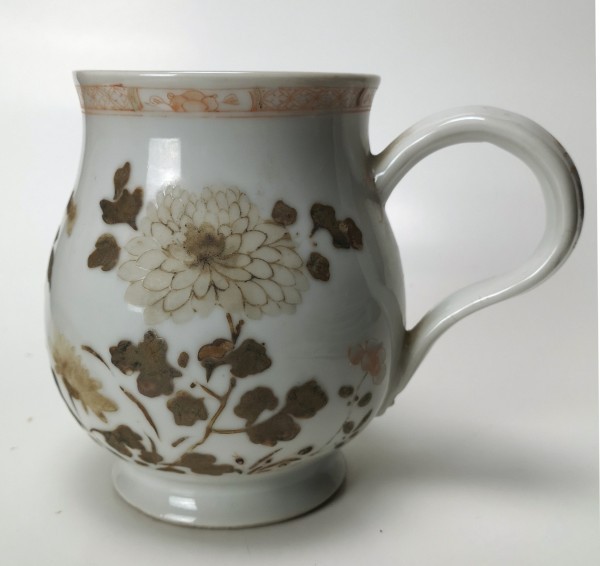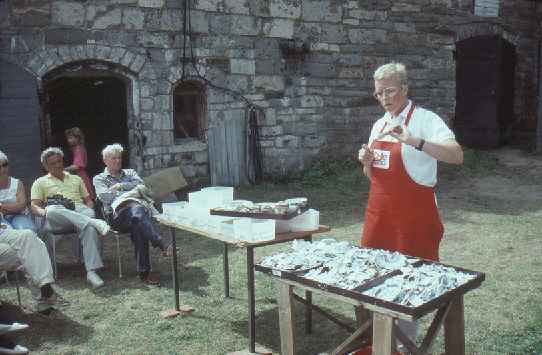


Berit, working with porcelain registration at the Älvsborgs Base camp
Between 1986 and 1991, a substantial amount of porcelain shards, totaling approximately 6 tons, was recovered from the excavation site of the Gotheborg III. Among these fragments, about 300 complete items were found. However, these complete items represented only a small portion of the ship's cargo, and the analysis of the cargo had to rely heavily on the shard finds.
From the cargo list of the ship we know the Gotheborg had carried 289 chests, 12 tubs and 238 bundles of porcelain, weighing all in all around 100 tons, this all in all probably being between 500,000 - 600,000 pieces. Any description of the actual content of these chests and bundles has not been found so far.
It is worth noting that even the shards themselves may not provide a comprehensive representation of the entire cargo. The assumption is that the cargo may have been salvaged shortly after the shipwreck, and the shards primarily consist of items that were discarded as damaged or broken during the recovery. This assumption is supported by historical evidence, such as a report from Diving Company Director Bagge in 1746, stating that further salvaging attempts were abandoned due to an impenetrable layer of soggy tea leaves covering the remaining cargo.
During the 18th century, diving technology limited the extent of underwater work to basic operations like locating cannons and securing ropes to larger objects for lifting. Salvaging at this time was an act of heroism undertaken at great personal risk. Subsequent salvaging efforts occurred when diving technology had improved, but the primary focus had shifted away from porcelain, as the demand for oriental porcelain had waned. Some porcelain items were still found during these later salvage operations, but there is no definitive documentation of the estimated half a million porcelain pieces that may still lie beneath the sea, possibly buried under layers of tea leaves.
It is plausible that over the course of 260 years, much of the porcelain cargo remained largely undisturbed beneath approximately 300 tons of tea leaves (dry weight). As the wreck deteriorated or was intentionally broken apart, the tea leaves and their contents could have spread downstream. Importantly, the Wästfelt excavation primarily concentrated on sample trenches and focused more on uncovering the ship's construction details than on finding the remaining porcelain cargo.
It is crucial to recognize that the excavation was carried out through voluntary work and private interest. At the time, the wreck site was deemed of little interest by harbor authorities. The subsequent value of the project in preserving the history of the East India trade in Gothenburg is owed to this voluntary effort, rather than the availability of public funding.
In 2003, after the harbor authorities dynamited the reef and dredged the area, divers still discovered Chinese porcelain shards on the exposed rock surfaces. These findings further support the idea that a significant portion of the porcelain cargo remained untouched.
To study the porcelain cargo, the shards were sorted into three main categories based on their decoration:
The most common type, characterized by blue decoration under the glaze. This type was relatively inexpensive to produce and has survived well in saltwater due to the protection provided by the glaze.
This type featured underglaze blue decoration combined with a brown iron-based glaze on the other side. It was less durable than underglaze blue porcelain and often exhibited encrustations on the brown glaze surface.
Around 10% of the shards featured this decoration, which combined underglaze blue cobalt with on-glaze enamels, including iron red and gold. Despite corrosion and degradation due to saltwater exposure, traces of the original colors could occasionally be seen.
In addition to these common types, various other enamel decorations were found on both the inside and outside of the porcelain pieces. These decorations had mostly lost their colors and were challenging to discern. Some attempts were made to re-fire shards to determine their original colors, revealing typical famille rose colors.

Traces of eroded enamel decoration found on the inside of a cup with Batavia brown outside
Tea leaves covering the excavation area preserved shards of enamel-decorated porcelain with intact colored enamels. These shards served as references for re-fired pieces, which closely matched the original colors.
Smaller quantities of rare porcelain types, such as 'powder blue' with gilt gold decorations and Laque burgauté (porcelain covered with Mother of Pearl and gold set in lacquer), were also recovered. Some completely white, undecorated porcelain pieces were among the findings. Additionally, a distinctive group included small figurines like dogs, incense burner stands, water droppers, and small seated Chinese boys.
Following the initial sorting, Berit Wästfelt embarked on the task of identifying the shapes of the porcelain fragments found within different groups. However, it's essential to note that despite significant efforts, comprehensive conclusions about the entire cargo were challenging to draw. In many cases, the shards were too small or scarce to provide definitive results. Some shards, although thick (1-2 cm), were diminutive (2-3 cm), indicating they might have come from very large objects.

Tea cup with the collection tag of the James Keiller collection. One of more than 100 motifs the blue and white decorations identified by Berit Wästfelt and successfully reconstructed.
In general, Wästfelt could ascertain that the majority of items within the available sample were predominantly cups, suitable for tea, coffee, and hot chocolate. This category included cups and saucers specifically designed for these beverages, as well as plates, dessert or fruit dishes of medium size, and bowls of medium dimensions. These items were well-suited for packing in bundles, aligning with the cargo list that listed 2,388 bundles.

A very unusual shape. Berit explained that in her entire experience of sorting 6 tonnes of shard from the excavation no pieces of this kind was registred. This jug is illustrated in Hvar 8 Dag as found during the Keiller excavation 1906-07. Bought from David Keiller, JE Nilsson Coll. 2023
.jpg)
Chopstick rest. One of a very limited number of this kind of pieces. One could speculate if these figures could have come from an irregular storage space since, despite being very few, they appear to have been found scattered over the whole area and still there, despite that almost everything of the ship and its cargo had disappeared over time. Bought from David Keiller. JE Nilsson Coll. 2023

Berit lecturing about porcelain registration at the Älvsborg Base Camp
One distinctive shape prevalent in the cargo was lidded jars of uncertain purpose. These jars were transported in nests of up to five, with smaller ones stored inside larger ones. Enamel decorations found on the inside walls of these jars indicated that the enameled decoration was fired with the pieces stacked inside each other, providing cost-efficiency in production. The Batavia brown jars with leaf-shaped reserves were the most common or at least typical examples of this type.

One of the most characteristic shapes of this cargo was lidded jars of uncertain purpose. They were transported in nests of up to five where the smaller were stored inside the larger. From fired enamels found on the inside walls of these jars it shows that the enameled decoration was fired with the pieces stacked inside each other giving great economy in production. The most common or at least typical are the Batavia brown with leaf shaped reserves. Photo: Jan-Erik Nilsson, 2005.
To a lesser extent, parts of tea sets or dinner dining sets with specially ordered decorations were found. Surprisingly, no dinner set components, except for two large dishes, were discovered among the blue and white porcelain fragments.
Speculation from the Wästfelt excavation and report suggests that a larger-than-proportionate share of the found shards might originate from porcelain packed in bundles rather than chests. The impact of the ship hitting the rocks likely caused most, if not all, of the porcelain on board to break and be abandoned at the wreck. This may explain the presence of many rare decorations that should not have been bundled.
Considering the shipwreck's historical reputation, it's also possible that some of the porcelain cargo was stored in irregular spaces not intended for discovery during the company's inspection upon arrival. It's important to note that these are speculative theories, but they have persisted as common knowledge regarding this ship's history.
After sorting by shape, Berit Wästfelt faced the challenge of differentiating the various motifs on the porcelain shards and attempting to reconstruct the shapes and decorations of complete items through drawing.
Due to numerous attempts to salvage the cargo over the centuries, many finds consisted of very small shards. Fortunately, the abundance of shards enabled the reconstruction of motifs, a process that spanned several years and is documented in her book. In summary, more than 100 motifs from the blue and white porcelain were successfully reconstructed.
Some of these motifs required over four years of collecting enough shards to form a complete motif.
A task left for future archaeologists is to investigate the colored portion of the cargo. While the enameled decoration has mostly vanished, it can still be studied through the faint etchings left in the glaze. Among these shards, besides a large number of exquisite Chinese-style flower motifs, at least seven different motifs with specifically commissioned Western-style decorations have been identified. Among these, at least two bear Coat of Arms, one of Swedish origin and the other Dutch.
As a unique curiosity, Berit Wästfelt mentions that only once was it possible to reconstruct one complete item from the shards found. During the summer of 1990, the shards of an underglaze blue and white bowl featuring a dragon motif were discovered. By the end of the excavation season, the bowl had almost been fully reconstructed, with the final missing piece found during one of the last days of the excavation. The dragon, surrounded by scrolling clouds, extended from the inside of the bowl over the edge to the outside, clutching a flaming pearl between its claws.
This complete dragon bowl earned a place of honor when the exhibition of finds from the Gotheborg was opened at the Flagstaff House Museum of Tea Ware in Hong Kong in March 1991.
Among the porcelain cargo, two armorial services were found, as well as three sets of porcelain featuring monograms or initials, one tea set with a portrait, one tea set with a motif copied from Meissen porcelain depicting two men sawing timber, and a punch bowl adorned with a copy of a medal. These unique items added diversity to the cargo and highlighted the distinct tastes and preferences of the time.
Between 1986 and 1991, the excavation of the Gotheborg III shipwreck yielded approximately 6 tons of porcelain shards, with around 300 complete items. These finds, while significant, represented only a small portion of the original cargo, which likely consisted of half a million to 600,000 porcelain pieces. The shards provided essential clues about the cargo, and the recovery process was marked by the challenges of 18th-century diving technology and the passage of time.
The analysis categorized porcelain shards into three main decoration types: underglaze blue, Café au lait (Batavia), and Chinese Imari, with various other enamel decorations also present. The preservation of some enamel-decorated shards within layers of tea leaves aided in understanding the original colors. Additionally, smaller quantities of unique porcelain types and figurines were found, adding to the ship's historical and archaeological significance.
This text is based on Berit Wästfelts et. al. report 'Porcelain from the East Indiaman Götheborg, 1990, combined with own research and observations.